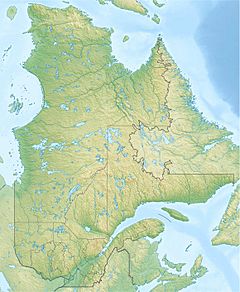Cloutier River facts for kids
Quick facts for kids Cloutier River |
|
|---|---|
| Native name | Rivière Cloutier |
| Country | Canada |
| Province | Quebec |
| Region | Chaudière-Appalaches |
| MRC | Montmagny Regional County Municipality |
| Physical characteristics | |
| Main source | Mountain and forest streams Sainte-Apolline-de-Patton 455 metres (1,493 ft) 46°49′57″N 70°16′45″W / 46.832372°N 70.279166°W |
| River mouth | St. Lawrence River Sainte-Apolline-de-Patton 360 metres (1,180 ft) 46°55′06″N 70°15′33″W / 46.91833°N 70.25916°W |
| Length | 16.9 kilometres (10.5 mi) |
| Basin features | |
| Progression | Bras Saint-Nicolas, rivière du Sud (Montmagny), St. Lawrence River |
| Tributaries |
|
The Cloutier River (known as rivière Cloutier in French) is a river in Quebec, Canada. It flows through several towns like Sainte-Apolline-de-Patton, Notre-Dame-du-Rosaire, and Cap-Saint-Ignace. These towns are part of the Montmagny Regional County Municipality in the Chaudière-Appalaches region.
The Cloutier River is a smaller river that flows into the Bras Saint-Nicolas. The Bras Saint-Nicolas then joins the rivière du Sud (Montmagny). Finally, the rivière du Sud flows into the mighty St. Lawrence River.
Where the Cloutier River Flows
The Cloutier River is part of a larger system of rivers and streams. A watershed is an area of land where all the water drains into a common river or lake. Here are some of the main watersheds near the Cloutier River:
- To the north: The St. Lawrence River, Bras Saint-Nicolas, and Inconnue River.
- To the east: The Bras Saint-Nicolas and Méchant Pouce River.
- To the south: The rivière du Sud (Montmagny), Fraser River, and Alick River.
- To the west: The rivière des Perdrix and the rivière du Sud (Montmagny).
The River's Beginning
The Cloutier River starts high up on the northern side of the Notre Dame Mountains. This is in the town of Sainte-Apolline-de-Patton. Many small streams from the mountains and forests come together to form the very beginning of the Cloutier River.
The River's Journey
From where it begins, the Cloutier River travels about 16.9 kilometres (10.5 mi) (about 10.5 miles). As it flows, the river drops about 95 metres (312 ft) (about 312 feet) in elevation.
Here's how its journey is divided:
- For the first 4.8 kilometres (3.0 mi), it flows north and then curves west. This part is in Sainte-Apolline-de-Patton, reaching the border of Notre-Dame-du-Rosaire.
- Next, it flows 1.1 kilometres (0.68 mi) northward. It reaches the border between the areas of Ashburton (in Notre-Dame-du-Rosaire) and Bourdages (in Sainte-Apolline-de-Patton).
- Then, it travels 7.3 kilometres (4.5 mi) northeast. This section goes up to the border between Sainte-Apolline-de-Patton and Cap-Saint-Ignace.
- It forms a small loop towards the north for 0.6 kilometres (0.37 mi) in Cap-Saint-Ignace, before returning to the Sainte-Apolline-de-Patton border.
- Finally, it flows 3.1 kilometres (1.9 mi) northeast until it meets another river.
The Cloutier River eventually flows into the southwest side of the Bras Saint-Nicolas. This meeting point is located after the mouth of the Méchant Pouce River.
River Name
The name "Rivière Cloutier" was officially recognized on December 5, 1968. This was done by the Commission de toponymie du Québec, which is the official body that names places in Quebec.


